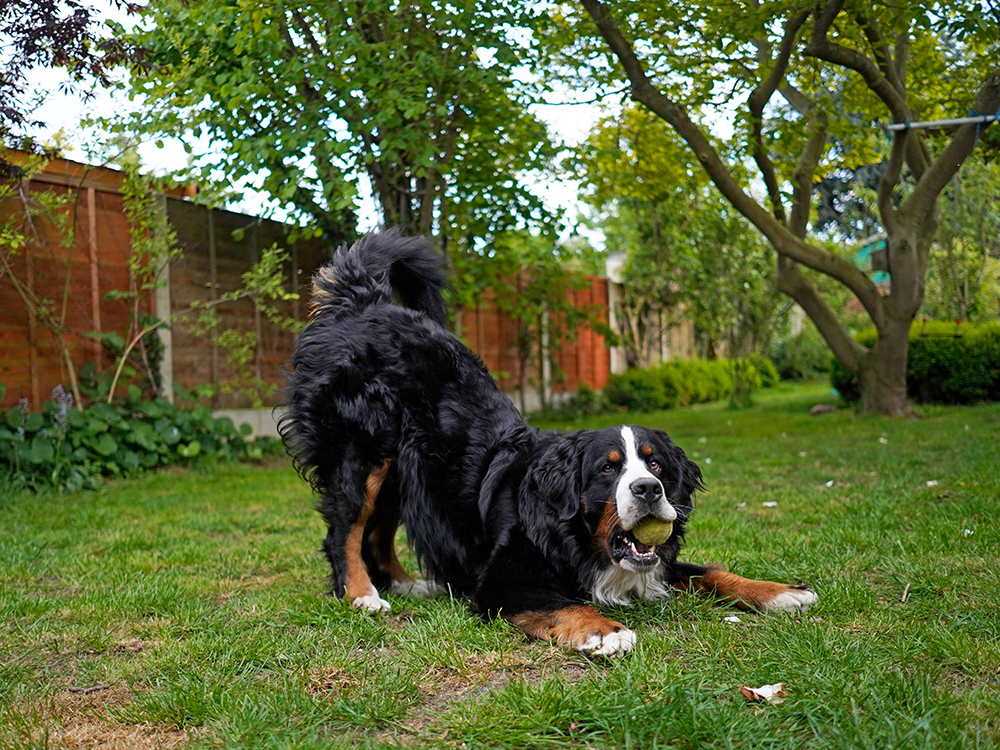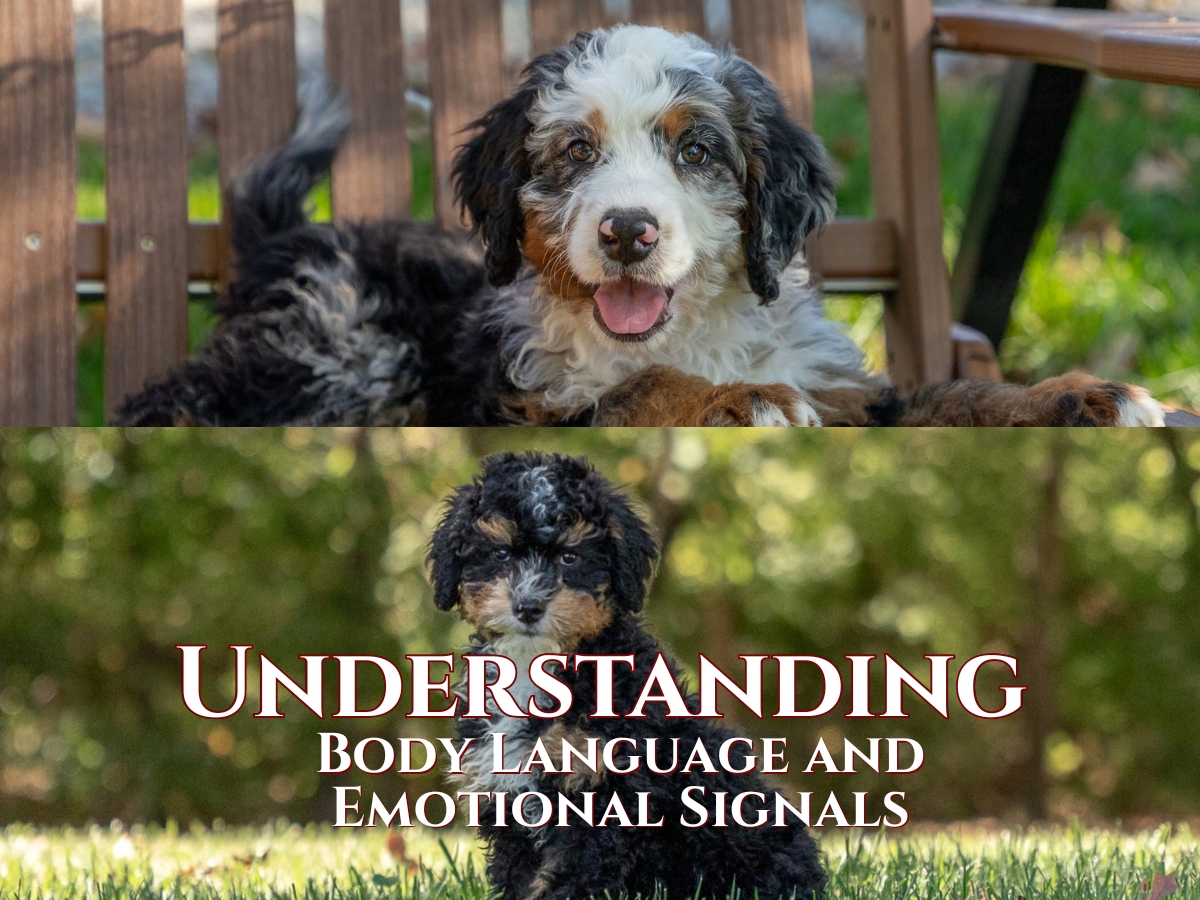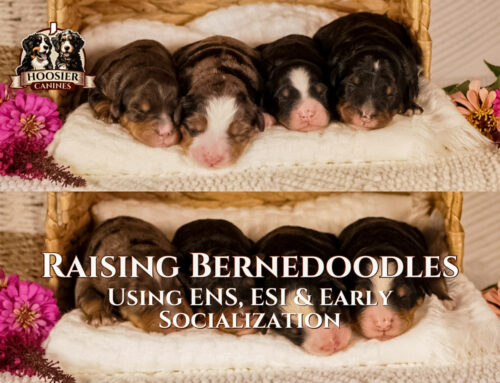Reading Your Bernedoodle | A Complete Guide to Understanding Body Language and Emotional Signals
Understanding your Bernedoodle goes far beyond basic obedience commands and training. These intelligent, expressive dogs communicate constantly through their body language, facial expressions, and subtle behavioral cues. At Hoosier Canines, we believe that learning to “speak dog” is one of the most valuable skills any Bernedoodle owner can develop. This comprehensive guide will help you decode what your fdog is telling you, strengthen your bond, and ensure their emotional well-being throughout their life.
While Bernedoodles inherit the gentle nature of the Bernese Mountain Dog and the intelligence of the Poodle, they possess their own unique communication style that every owner should understand. By learning to read their body language accurately, you’ll be able to respond appropriately to their needs, prevent behavioral problems before they escalate, and create a deeper, more meaningful relationship with your beloved companion.

The Basics of Canine Communication
Before diving into specific body language signals, it’s important to understand that dogs communicate through multiple channels simultaneously. Your Bernedoodle uses their entire body—from the tip of their nose to the end of their tail—to express themselves. Context is crucial when interpreting these signals. A wagging tail doesn’t always mean happiness, and a yawn isn’t always about being tired.
The Five Key Areas to Observe:
Dogs primarily communicate through five main body parts: their tail, ears, eyes, mouth, and overall body posture. Each of these areas provides valuable information, but the true meaning emerges when you consider all signals together in context. For Bernedoodles, this can be slightly more challenging because their fluffy coats and floppy ears sometimes mask subtle signals, making it even more important to pay close attention to the details.
Additionally, Bernedoodles may display different communication patterns based on which parent breed they take after more strongly. Those with more Bernese Mountain Dog characteristics may be more stoic and subtle in their communication, while those favoring their Poodle heritage might be more expressive and animated.
Dog body language chart showing how to interpret common dog emotions and behaviors through posture and facial signals
Why Understanding Bernedoodle Body Language Matters
Dogs cannot speak our language, but they are constantly communicating. Every tail wag, ear position, and facial expression tells a story about what your Bernedoodle is feeling and thinking. Understanding these signals is not just about better communication. It needs to be about safety, training effectiveness, and your dog’s overall quality of life.
When you can accurately interpret your Bernedoodle’s emotional state, you become better equipped to prevent stressful situations, identify when they’re uncomfortable or anxious, and respond to their needs before small issues become major behavioral problems. This skill is particularly important for Bernedoodles, who are known for their strong attachment to their families and can experience separation anxiety or stress when their emotional needs aren’t met.
Research in canine behavior has shown that dogs who have owners that understand their communication signals tend to have fewer behavioral issues, lower stress levels, and stronger bonds with their human families. For intelligent breeds like Bernedoodles, this understanding becomes even more critical, as they are constantly processing their environment and responding to subtle changes in household dynamics.

Tail Language: More Than Just Wagging
The tail is often the first thing people look at when trying to gauge a dog’s mood, but tail language is far more nuanced than most realize. The position, speed, and direction of your Bernedoodle’s tail all convey important information about their emotional state.
Tail Position and What It Means:
A relaxed, neutral tail hangs naturally with perhaps a gentle sway—this indicates your Bernedoodle is calm and comfortable in their environment. A high, flagging tail suggests confidence or potentially assertiveness, and in some contexts, this can signal that your dog is aroused or on alert. Conversely, a tucked tail between the legs is a clear sign of fear, stress, or submission.
The Speed and Type of Wag:
The speed of the tail wag indicates the level of arousal or excitement your Bernedoodle is experiencing. Slow, sweeping wags that involve the whole rear end typically indicate a relaxed, happy dog greeting someone they love. Fast, stiff wags suggest high arousal, which could be excitement but might also indicate tension or agitation. The famous “helicopter tail”—where the tail spins in full circles—is an unmistakable sign of pure joy, often seen when Bernedoodles greet their beloved family members after an absence.
Research has even shown that the direction of tail wagging matters. Dogs tend to wag more to the right when experiencing positive emotions and more to the left when encountering something negative or concerning. While this subtle distinction can be hard to catch, it demonstrates just how sophisticated canine communication truly is.
Ears: Windows to Emotion
Ear position is another critical component of canine body language. While Bernedoodles typically have floppy ears that hang down, you can still observe meaningful changes in ear position that reveal their emotional state.
Forward-Facing Ears:
When your Bernedoodle’s ears move forward and slightly up at the base (even if the tips still flop), they are showing interest, curiosity, or alertness. This is the position you’ll often see when they hear an interesting sound or notice something that catches their attention. It’s a sign of engagement with their environment.
Relaxed, Neutral Ears:
Ears that sit naturally in their default position without tension indicate a relaxed, comfortable dog. For Bernedoodles, this means the ears hang softly without being pulled forward or pressed back against the head.
Ears Pulled Back:
When ears are pulled back and held close to the head, the meaning depends on the context and accompanying body language. Slight pulling back with a relaxed body often indicates friendliness and submission in a positive way. However, ears pinned tightly against the head combined with other stress signals indicate fear, anxiety, or potential defensive aggression.
The Eyes: Mirrors of the Soul
Your Bernedoodle’s eyes are incredibly expressive and provide valuable insight into their emotional state. Learning to read eye signals can help you identify stress, fear, happiness, or potential aggression before situations escalate.
Soft, Relaxed Eyes:
When your Bernedoodle is content and relaxed, their eyes will appear soft, with a gentle, almost squinty appearance. The muscles around the eyes are loose, and their gaze is indirect and non-threatening. This is the look of a happy, comfortable dog.
Hard Stare: A direct, hard stare with tense facial muscles is a warning signal. In dog language, staring is considered rude and potentially threatening. If your Bernedoodle is giving another dog or person a hard stare, they are likely feeling threatened or are issuing a warning to back off. This is particularly important to recognize in multi-dog households or when introducing your Bernedoodle to new animals.
Whale Eye (Showing Whites of Eyes):
When you can see the whites of your dog’s eyes—often called “whale eye” or “half-moon eye”—it typically indicates stress, anxiety, or discomfort. Your Bernedoodle might display this when they’re worried about something in their environment, feel cornered, or are experiencing resource guarding. This signal should never be ignored, as it often precedes more obvious stress responses.
Avoiding Eye Contact: When dogs deliberately look away or avoid eye contact, they are using a calming signal to diffuse tension. This is polite behavior in dog language and shows that your Bernedoodle is not seeking confrontation. You might see this when you’re scolding them or in situations where they feel uncertain.
Mouth and Facial Expressions
The mouth area provides numerous clues about your Bernedoodle’s emotional state. From relaxed panting to tension in the muzzle, these signals are essential to understand.
The Relaxed, Open Mouth:
A slightly open mouth with the tongue visible, often described as a “dog smile,” is a sign of a happy, relaxed Bernedoodle. When combined with soft eyes and relaxed body posture, this is the expression of contentment you want to see regularly.
Lip Licking and Nose Licking:
Frequent lip licking when no food is present is a stress signal. Your Bernedoodle may lick their lips repeatedly when they’re anxious, uncomfortable, or trying to calm themselves down. This is one of those subtle signals that’s easy to miss but incredibly informative about your dog’s internal state.

Yawning:
While dogs do yawn when tired, they also yawn as a stress-relief mechanism. If your Bernedoodle yawns repeatedly during a training session, grooming appointment, or vet visit, they’re likely experiencing stress and trying to self-soothe. Recognizing this allows you to slow down, take breaks, or adjust the situation to reduce their anxiety.
Showing Teeth:
A curled lip revealing teeth, especially accompanied by a wrinkled muzzle and stiff body, is a clear warning signal. Your Bernedoodle is communicating that they are uncomfortable and warning others to back away. Never ignore this signal, as it often precedes more aggressive behavior if the warning is not heeded.
Panting:
While panting is normal for temperature regulation and after exercise, excessive panting in cool environments or when your dog hasn’t been active indicates stress or anxiety. Pay attention to the context and other body language signals to determine if your Bernedoodle is simply hot or experiencing emotional distress.
Body Posture: The Big Picture
Overall body posture ties all the individual signals together and provides the complete picture of your Bernedoodle’s emotional state. Understanding these postural signals helps you read the room and respond appropriately to your dog’s needs.
Relaxed and Loose:
A happy, comfortable Bernedoodle has a loose, wiggly body with weight distributed evenly. Their movements are fluid and natural, without tension or stiffness. This is the body language you want to see most of the time, it indicates a well-adjusted, content dog.
Play Bow:
The classic play bow, front end down with rear end up, is generally an invitation to play. However, context matters. While this is usually a friendly gesture, dogs sometimes use play bows as calming signals or to interrupt tension between other dogs. Watch the rest of the body language to determine the true intent.


Stress Signals and Calming Behaviors
Bernedoodles, like all dogs, display specific behaviors when they’re stressed or trying to calm themselves or others. Recognizing these signals is crucial for preventing anxiety and behavioral problems.
Common Stress Signals:
Your Bernedoodle may display several stress indicators including excessive panting when not hot, drooling, trembling, pacing, inability to settle, loss of appetite, excessive shedding, or digestive upset. During stressful situations like thunderstorms, vet visits, or when meeting new people, watch for these signs and provide comfort and reassurance.
Calming Signals:
Dogs use specific behaviors to communicate peaceful intentions and reduce tension in social situations. These include turning their head away, sniffing the ground, moving slowly, sitting or lying down, yawning, lip licking, and creating distance. When your Bernedoodle displays these behaviors, they’re essentially saying “I’m not a threat” or “let’s all calm down.”
Understanding these signals helps you recognize when your Bernedoodle is uncomfortable in social situations, whether with other dogs at the park or during family gatherings. It also helps you avoid misinterpreting their behavior—what might look like disobedience (such as sniffing the ground when you call them) might actually be a stress response or calming signal.






